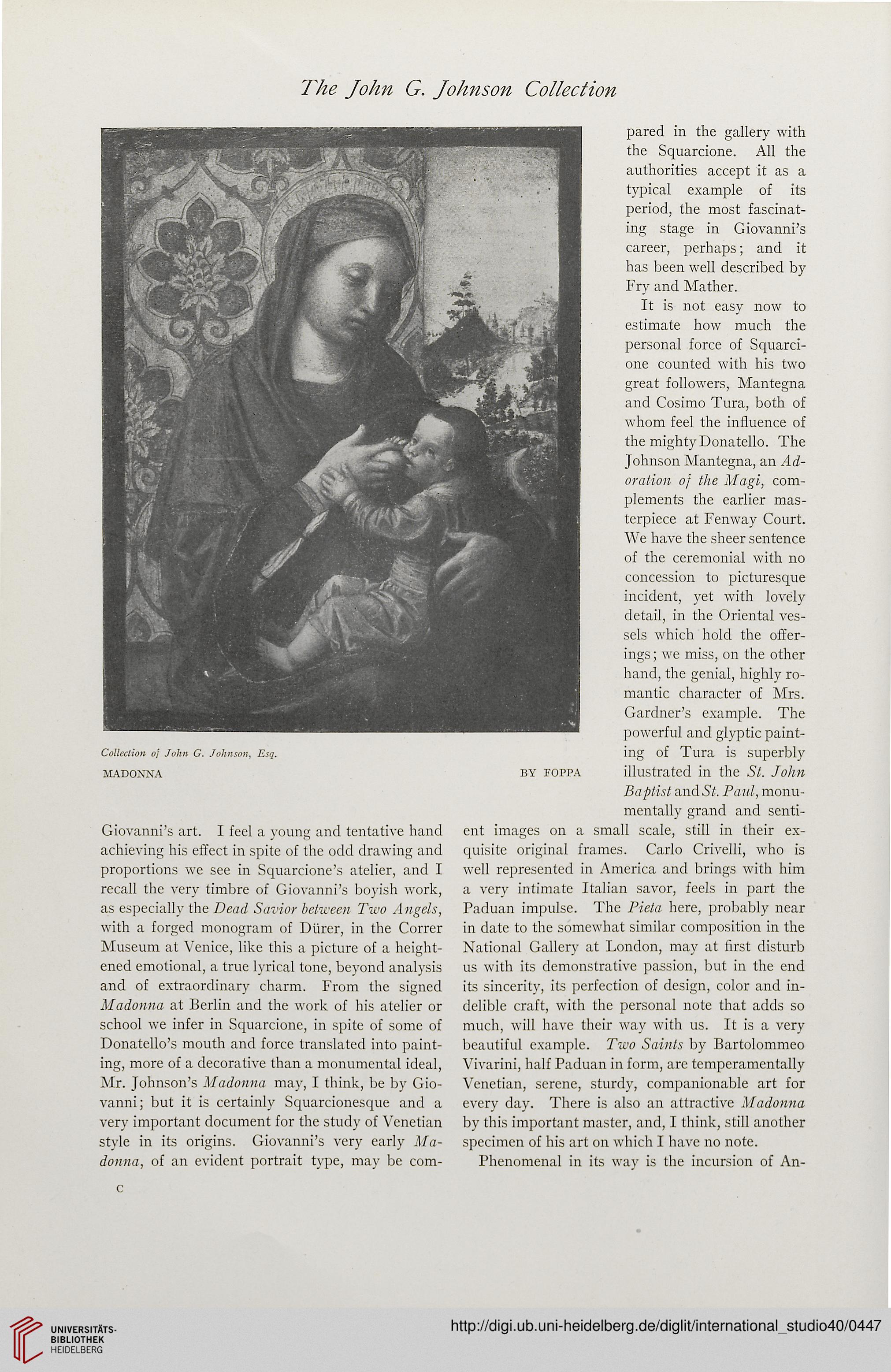The John G. Johnson Collection
pared in the gallery with
the Squarcione. All the
authorities accept it as a
typical example of its
period, the most fascinat-
ing stage in Giovanni's
career, perhaps; and it
has been well described by
Fry and Mather.
It is not easy now to
estimate how much the
personal force of Squarci-
one counted with his two
great followers, Mantegna
and Cosimo Tura, both of
whom feel the influence of
the mighty Donatello. The
Johnson Mantegna, an Ad-
oration of the Magi, com-
plements the earlier mas-
terpiece at Fenway Court.
We have the sheer sentence
of the ceremonial with no
concession to picturesque
incident, yet with lovely
detail, in the Oriental ves-
sels which hold the offer-
ings ; we miss, on the other
hand, the genial, highly ro-
mantic character of Mrs.
Gardner's example. The
powerful and glyptic paint-
Coiicciion o] John g. Johnson, Esq. ing of Tura is superbly
madonna by foppa illustrated in the St. John
Baptist and St. Paul, monu-
mentally grand and senti-
Giovanni's art. I feel a young and tentative hand ent images on a small scale, still in their ex-
achieving his effect in spite of the odd drawing and quisite original frames. Carlo Crivelli, who is
proportions we see in Squarcione's atelier, and I well represented in America and brings with him
recall the very timbre of Giovanni's boyish work, a very intimate Italian savor, feels in part the
as especially the Dead Savior between Two Angels, Paduan impulse. The Pieta here, probably near
with a forged monogram of Dtirer, in the Correr in date to the somewhat similar composition in the
Museum at Venice, like this a picture of a height- National Gallery at London, may at first disturb
ened emotional, a true lyrical tone, beyond analysis us with its demonstrative passion, but in the end
and of extraordinary charm. From the signed its sincerity, its perfection of design, color and in-
Madonna at Berlin and the work of his atelier or delible craft, with the personal note that adds so
school we infer in Squarcione, in spite of some of much, will have their way with us. It is a very
Donatello's mouth and force translated into paint- beautiful example. Two Saints by Bartolommeo
ing, more of a decorative than a monumental ideal, Vivarini, half Paduan in form, are temperamentally
Mr. Johnson's Madonna may, I think, be by Gio- Venetian, serene, sturdy, companionable art for
vanni; but it is certainly Squarcionesque and a every day. There is also an attractive Madonna
very important document for the study of Venetian by this important master, and, I think, still another
style in its origins. Giovanni's very early Ma- specimen of his art on which I have no note.
donna, of an evident portrait type, may be com- Phenomenal in its way is the incursion of An-
c
pared in the gallery with
the Squarcione. All the
authorities accept it as a
typical example of its
period, the most fascinat-
ing stage in Giovanni's
career, perhaps; and it
has been well described by
Fry and Mather.
It is not easy now to
estimate how much the
personal force of Squarci-
one counted with his two
great followers, Mantegna
and Cosimo Tura, both of
whom feel the influence of
the mighty Donatello. The
Johnson Mantegna, an Ad-
oration of the Magi, com-
plements the earlier mas-
terpiece at Fenway Court.
We have the sheer sentence
of the ceremonial with no
concession to picturesque
incident, yet with lovely
detail, in the Oriental ves-
sels which hold the offer-
ings ; we miss, on the other
hand, the genial, highly ro-
mantic character of Mrs.
Gardner's example. The
powerful and glyptic paint-
Coiicciion o] John g. Johnson, Esq. ing of Tura is superbly
madonna by foppa illustrated in the St. John
Baptist and St. Paul, monu-
mentally grand and senti-
Giovanni's art. I feel a young and tentative hand ent images on a small scale, still in their ex-
achieving his effect in spite of the odd drawing and quisite original frames. Carlo Crivelli, who is
proportions we see in Squarcione's atelier, and I well represented in America and brings with him
recall the very timbre of Giovanni's boyish work, a very intimate Italian savor, feels in part the
as especially the Dead Savior between Two Angels, Paduan impulse. The Pieta here, probably near
with a forged monogram of Dtirer, in the Correr in date to the somewhat similar composition in the
Museum at Venice, like this a picture of a height- National Gallery at London, may at first disturb
ened emotional, a true lyrical tone, beyond analysis us with its demonstrative passion, but in the end
and of extraordinary charm. From the signed its sincerity, its perfection of design, color and in-
Madonna at Berlin and the work of his atelier or delible craft, with the personal note that adds so
school we infer in Squarcione, in spite of some of much, will have their way with us. It is a very
Donatello's mouth and force translated into paint- beautiful example. Two Saints by Bartolommeo
ing, more of a decorative than a monumental ideal, Vivarini, half Paduan in form, are temperamentally
Mr. Johnson's Madonna may, I think, be by Gio- Venetian, serene, sturdy, companionable art for
vanni; but it is certainly Squarcionesque and a every day. There is also an attractive Madonna
very important document for the study of Venetian by this important master, and, I think, still another
style in its origins. Giovanni's very early Ma- specimen of his art on which I have no note.
donna, of an evident portrait type, may be com- Phenomenal in its way is the incursion of An-
c




